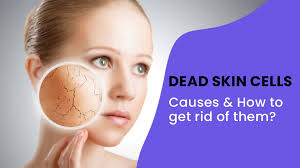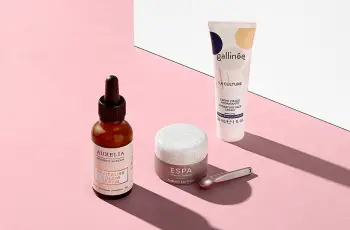
Dead Skin Cells: Causes, Effects, and How to Remove Them
Our skin is constantly renewing itself, shedding dead skin cells in a natural process known as desquamation. This cycle is essential for maintaining a healthy and glowing complexion.
However, when dead skin cells build up on the skin’s surface, it can lead to a range of skin issues, including dryness, flakiness, clogged pores, and a dull appearance.
In this article, we will delve into what dead skin cells are, why they accumulate, and how you can effectively remove them for smoother, healthier skin.
If you’re unsure about your skin type and need personalized advice, you can take our free skin type quiz to discover the best skincare routine for your needs.
What Are Dead Skin Cells?
Dead skin cells are the remnants of your skin’s natural cell turnover process. Every day, your skin sheds old cells from the outermost layer, called the epidermis, to make way for new, fresh cells underneath.
This cycle of renewal, or desquamation, ensures that your skin stays healthy, vibrant, and protected from harmful external factors.
However, when the skin fails to shed these cells properly, they can accumulate, resulting in dull, dry, and congested skin.
Causes of Dead Skin Cell Buildup
Dead skin cells accumulate for a variety of reasons. Understanding the root cause of this buildup is essential for determining the right course of treatment.
1. Aging
As we age, our skin’s cell turnover rate naturally slows down. This means that old skin cells linger on the surface for longer periods before shedding.
As a result, the skin can appear dull, rough, or uneven, and it may feel dry or flaky.
2. Dehydration
When your skin is dehydrated, it becomes difficult for dead skin cells to naturally shed. Instead of flaking off on their own, they may cling to the surface of the skin, exacerbating dryness and dullness.
3. Improper Skin Care
Using the wrong skincare products, or failing to exfoliate regularly, can interfere with the natural process of cell turnover.
For instance, some skincare products may be too harsh or not suitable for your skin type, causing irritation that prevents your skin from shedding dead cells properly.
4. Environmental Factors
Pollution, sun exposure, and harsh weather conditions can damage the skin’s protective barrier, making it harder for dead skin cells to shed naturally.
Exposure to UV rays also accelerates skin aging, further slowing down the cell turnover process.
5. Skin Conditions
Certain skin conditions, such as eczema, psoriasis, and acne, can disrupt the normal shedding of skin cells.
These conditions often result in dryness, itching, or the formation of scaly patches, making it harder for the skin to exfoliate itself.
Signs That Dead Skin Cells Are Buildup
You may notice various signs that indicate a buildup of dead skin cells on your face. Common symptoms include:
Dry, flaky skin, Dull, lackluster complexion, Itching or discomfort, Rough patches on the skin, Clogged pores or blackheads, Uneven skin tone or texture
If you’re experiencing any of these issues, your skin may not be shedding dead skin cells as efficiently as it should be, and exfoliation could help.
How to Remove Dead Skin Cells from the Face
Exfoliation is the most effective way to remove dead skin cells from the surface of your skin. By regularly exfoliating, you help loosen the bonds that hold dead skin cells in place, allowing them to be removed.
There are two primary methods for exfoliating: chemical exfoliation and physical exfoliation.
Chemical Exfoliation
Chemical exfoliation involves using acids or enzymes to dissolve dead skin cells. These exfoliants penetrate the skin and break down the bonds that hold cells together. Some common chemical exfoliants include:
Alpha Hydroxy Acids (AHAs): These water-soluble acids, such as glycolic acid and lactic acid, are effective at exfoliating the outer layer of the skin and brightening the complexion.
Beta Hydroxy Acid (BHA): The most common BHA is salicylic acid, which is oil-soluble and can penetrate deeper into pores to clear out clogged follicles, making it ideal for acne-prone skin.
Chemical exfoliation is particularly effective for those with dry or sensitive skin.
However, it’s important to start slowly, introducing AHAs into your skincare routine once a week, then gradually increasing frequency as your skin tolerates it.
Sensitive skin types may only be able to handle chemical exfoliation once a week, while more resilient skin can tolerate 2–3 times a week.
Physical Exfoliation
Physical exfoliation uses a scrub or tool to manually remove dead skin cells from the surface of the skin.
This can be done using a facial scrub or tools like a loofah. While physical exfoliation is effective, it can be too harsh for sensitive skin, especially if you use rough exfoliants or apply too much pressure.
For best results, look for scrubs with fine particles. A gentle scrub, such as La Roche-Posay’s Ultra-Fine Facial Scrub, is ideal as it won’t irritate the skin but will still help slough off dead skin cells.
Best Exfoliating Products for Dull Skin
If your skin is dry and dull, incorporating exfoliating products into your routine can significantly improve its texture and glow. Here are a few recommended products for dull skin:
Glycolic Acid Cleanser: This cleanser uses glycolic acid, an AHA, to exfoliate and brighten the skin without stripping moisture. It’s perfect for improving skin texture and clarity.
Salicylic Acid Exfoliator: Ideal for acne-prone skin, salicylic acid helps penetrate deep into pores to clear out oil and dead skin cells.
Lactic Acid Cream: For a gentler exfoliation, a lactic acid moisturizer can help hydrate and exfoliate at the same time, making it great for sensitive or dry skin.
How to Prevent Dead Skin Cell Buildup
While it’s impossible to completely stop your skin from producing dead cells, there are steps you can take to prevent them from building up and causing issues.
1. Regularly Exfoliate
Exfoliation should be a regular part of your skincare routine to help remove dead skin cells before they have a chance to accumulate. Choose a gentle exfoliant that works well with your skin type.
2. Moisturize Daily
Keeping your skin hydrated helps dead skin cells naturally shed off the surface. Use a good moisturizer to lock in hydration and keep the skin smooth and soft.
This will also prevent dead skin from sticking to your skin.
3. Use the Right Cleanser
Choose a gentle, hydrating cleanser that matches your skin type. Harsh cleansers can strip the skin of essential oils, which can lead to dehydration and buildup of dead skin cells.
4. Protect Your Skin from Sun Damage
Sun exposure damages the skin’s ability to shed dead cells. To avoid this, wear sunscreen every day, even on cloudy days. Sunscreen helps protect your skin from UV damage that can slow down cell turnover.
5. Eat a Balanced Diet
A healthy diet, rich in antioxidants and vitamins, supports your skin’s overall health and its natural exfoliation process.
Include foods high in vitamins C and E, such as citrus fruits, leafy greens, and nuts, to promote healthy, glowing skin.
Bottom Line
Dead skin cells are an inevitable part of the skin’s renewal process. While this shedding is vital for healthy skin, excessive buildup of dead skin cells can cause dryness, clogged pores, and a dull complexion.
By incorporating regular exfoliation, proper hydration, and a sun protection regimen into your skincare routine, you can keep dead skin cells at bay and reveal a smoother, brighter complexion.
Understanding your skin type is essential for selecting the right exfoliating products and creating a customized skincare routine.
Remember, the key is consistency—regular care and maintenance will keep your skin glowing and fresh.


